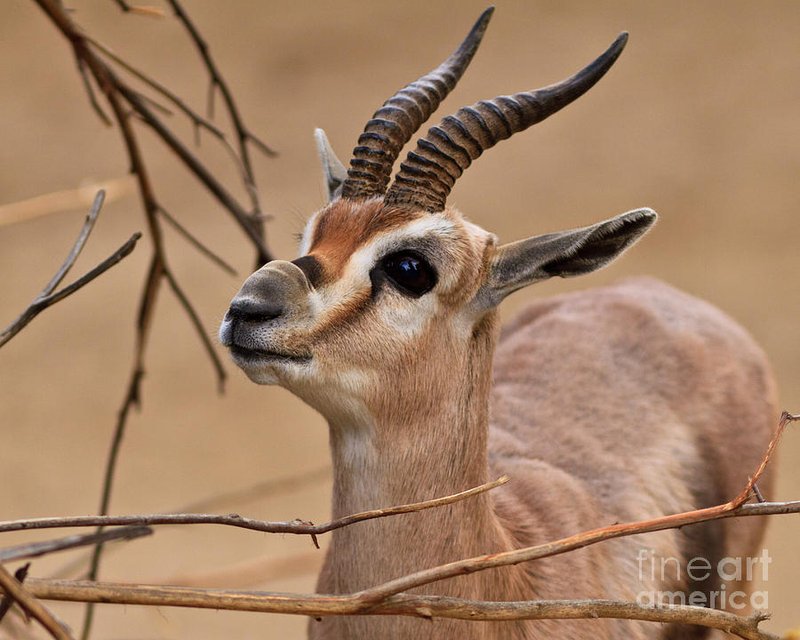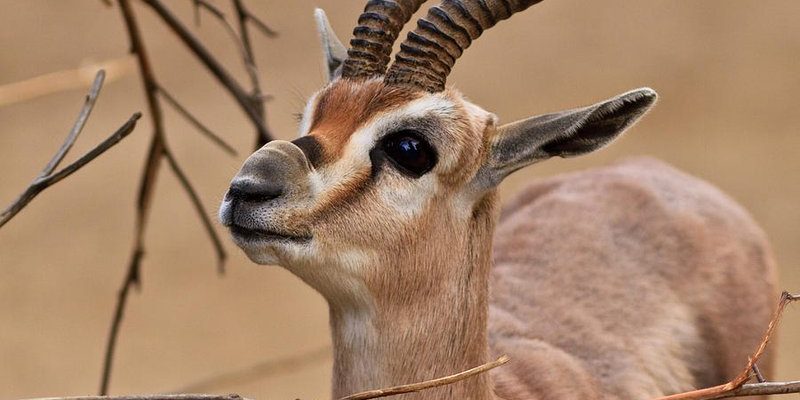
These nimble animals belong to the Bovidae family, which includes antelopes and cattle. Gazelles are primarily found in the savannas, grasslands, and open woodlands of Africa and parts of Asia. Their slender bodies and long legs are perfectly designed for evasion, allowing them to reach impressive speeds when escaping from predators. But there’s much more beneath the surface than just their looks. Let’s dive into the world of gazelles and explore what makes them so special!
Physical Characteristics
Gazelles are truly striking animals. With their slender limbs and elegant postures, they have a unique way of moving that catches the eye. The most well-known species is the Thomson’s gazelle, which stands about 24 to 30 inches tall at the shoulder. Their bodies are typically light tan, with white underbellies that help them blend into the dry grasses of their habitat. Interestingly, the black markings on their faces and legs serve a purpose—these markings are a form of camouflage, helping them hide from predators like lions and cheetahs.
One of the standout features of gazelles is their impressive adaptability. Many species have large, dark eyes, which provide excellent vision to monitor for threats, while their ears are sensitive enough to catch the slightest rustle in the grass. Their hooves are perfectly shaped for speed and agility, allowing for quick, sharp turns when fleeing from danger. The average gazelle can reach speeds of up to 50 miles per hour, making them one of the fastest land animals. They also have a unique method of running called “stotting,” where they leap high into the air to display their strength and fitness to potential predators.
Their physical characteristics aren’t just for show; they are essential for survival. By being able to outrun predators and navigate their environment swiftly, gazelles increase their chances of survival in the wild, which leads us to their remarkable behaviors.
Behavior and Social Structure
Gazelles are social animals, typically found in herds ranging from just a few individuals to several hundred. The size of these herds can change throughout the year, depending on the availability of food and water. Within these groups, gazelles exhibit fascinating social behaviors. For instance, males often engage in displays of dominance, which can include impressive leaps and vocalizations. These behaviors help establish hierarchy and maintain peace within the group.
You might be curious about their mating rituals as well. During the breeding season, dominant males will gather groups of females, displaying their strength to attract mates. It’s like a dance, where every leap and gesture communicates fitness and desirability. After mating, females give birth to a single calf, which they hide in tall grass to protect it from predators. This protective behavior is crucial; newborn gazelles are particularly vulnerable during their first few weeks of life.
In terms of communication, gazelles are known to use a variety of vocalizations, including bleats, snorts, and even low grunts. These sounds serve different purposes, from alerting the herd of danger to reassuring each other. Gazelles also communicate through body language, using posture and movement to express emotions. This intricate social structure not only supports their survival but also fosters connections within the herd.
Habitat and Distribution
Gazelles primarily inhabit open grasslands, savannas, and scrublands. You can find them in various countries across Africa, such as Kenya, Tanzania, and South Africa. Some species, like the Persian gazelle, are found in parts of Iran. The environmental conditions in these regions greatly influence their behavior and lifestyle. For example, they thrive in areas where food and water are plentiful, which allows them to maintain their energetic lifestyles.
The climate in these habitats can vary significantly, ranging from hot, dry seasons to cooler, wetter periods. Gazelles have adapted to these conditions by becoming migratory, often traveling long distances in search of food and water. This ability to move based on environmental cues is essential for their survival. During the dry season, for instance, they might migrate to areas where there is more vegetation available. It’s like following the seasons on a journey, always seeking the best conditions to thrive.
To visualize their distribution, consider creating a simple HTML table summarizing key facts about gazelles. Here’s a quick look at some interesting statistics:
| Species | Thomson’s Gazelle | Grant’s Gazelle | Persian Gazelle |
| Average Height | 24-30 inches | 30-36 inches | 27-33 inches |
| Speed | 50 mph | 45 mph | 40 mph |
| Habitat | Grasslands, Savannas | Woodlands, Grasslands | Desert Regions |
| Diet | Herbivore | Herbivore | Herbivore |
| Population | Vulnerable | Stable | Endangered |
This table highlights the different gazelle species and some of the interesting stats that help paint a clearer picture of these beautiful creatures and their existence.
Diet and Nutrition
As herbivores, gazelles have a diet that primarily consists of grasses and shrubs. They are specially adapted to graze on low-lying vegetation, which is abundant in their habitats. Gazelles have a unique digestive system that allows them to extract the maximum amount of nutrients from the tough plant materials they consume. This system includes a four-chambered stomach, similar to that of cows, which aids in breaking down the fibrous content of their diet.
One fascinating aspect of their eating habits is their ability to adjust their diet based on the season. During the wet season, when grasses are abundant and lush, gazelles indulge in this fresh vegetation to build up fat reserves for the drier months. Conversely, during the dry season, they may switch to tougher, more fibrous grasses or browse on shrubs—showing just how adaptable they can be when it comes to finding sustenance.
You might be wondering what role gazelles play in their ecosystem. By grazing on grasses, they help maintain the health of the savanna landscape, preventing overgrowth and promoting the growth of new plants. This, in turn, supports other species and maintains a balanced ecosystem. Gazelles are essential players in their environments, impacting everything from soil health to the presence of other wildlife.
Conservation Status
The conservation status of gazelles varies widely across species, with some populations facing significant threats. For example, the Persian gazelle is listed as endangered, primarily due to habitat loss and hunting. As agricultural lands expand, these animals lose their natural habitats, making it more challenging for them to find food and shelter. Conservation efforts are vital for protecting these creatures and the ecosystems they inhabit.
In contrast, the Thomson’s gazelle population is more stable, but even they face pressures from habitat degradation and poaching. One of the main challenges for all gazelles is the balance between human activity and wildlife conservation. Protected areas and national parks play a crucial role in safeguarding their habitats, but enforcement of these protections can be inconsistent.
You might be surprised to learn that local communities also play a pivotal role in gazelle conservation. By promoting eco-tourism and raising awareness about the importance of these animals, they can help create a sustainable future for gazelles. Education and community involvement are key in ensuring that future generations can continue to appreciate these elegant creatures.
Interesting Facts About Gazelles
Gazelles are not just fascinating because of their speed and grace; they have a variety of unique traits that make them stand out. For instance, they can leap up to 10 feet in a single bound! This ability allows them to escape predators quickly and can even help them navigate through dense vegetation. Another remarkable fact is that gazelles can sustain high speeds for longer than many might expect, allowing them to outrun their pursuers over considerable distances.
Additionally, gazelles have a highly developed sense of hearing. This is crucial for detecting threats from afar, giving them an edge when it comes to survival. They often rely on each other to stay alert—if one gazelle senses danger, it will alert the others with a series of hops or vocalizations. This social behavior enhances the safety of the entire herd.
Lastly, despite their delicate appearance, gazelles are incredibly resilient animals. They can endure harsh weather and adapt to varying food availability. This resilience is a testament to their evolutionary success, allowing them to thrive in challenging environments for thousands of years.
FAQ
What is the main diet of a gazelle?
Gazelles are primarily herbivorous, feeding on grasses and shrubs found in their natural habitats. Their diet changes with the seasons. In wetter months, they enjoy fresh grass, while in dryer periods, they may turn to tougher, more fibrous plants. Their digestive systems are well-adapted to efficiently break down these plant materials, allowing them to get the nutrients they need to thrive.
How fast can a gazelle run?
Gazelles are renowned for their speed, capable of reaching up to 50 miles per hour. This incredible speed allows them to outrun predators, making them one of the fastest land animals. Their agility is just as impressive, as they can make sharp turns and leaps to evade capture, which is crucial for their survival.
Where do gazelles live?
Gazelles primarily inhabit grasslands, savannas, and scrublands across Africa and parts of Asia. They thrive in open habitats where food is abundant and can migrate long distances to find better conditions. Their distribution often coincides with the availability of grass and water, which is essential for their well-being.
Are gazelles social animals?
Yes, gazelles are social creatures that typically live in herds ranging from a few individuals to hundreds. Their social structure is complex, with males often displaying dominance through behaviors like vocalizations and impressive leaps. These social dynamics play a crucial role in their breeding practices and overall survival.
What are the major threats to gazelles?
The primary threats to gazelles include habitat loss due to agriculture and urbanization, hunting, and poaching. Conservation efforts are vital to protect these animals from extinction. Some species, like the Persian gazelle, are classified as endangered due to these pressures, highlighting the need for ongoing conservation work.
How long do gazelles typically live?
In the wild, the average lifespan of a gazelle is around 10 to 12 years, although some individuals can live longer under ideal conditions. Their lifespan can be affected by various factors, including predation, availability of resources, and environmental conditions.
What is the difference between gazelles and antelopes?
While all gazelles are types of antelopes, not all antelopes are gazelles. The term “antelope” refers to a broad group of hoofed mammals in the family Bovidae. Gazelles are a specific subset characterized by their slender bodies, long legs, and speed. Other antelopes may have different size, habitat, and behavioral characteristics.
Can gazelles survive in captivity?
Gazelles can survive in captivity, but their needs for space, social interaction, and environmental enrichment must be met. Zoos and wildlife sanctuaries work to provide environments that mimic their natural habitats, allowing them to thrive physically and behaviorally. Captive breeding programs also contribute to conservation efforts for endangered species.
Do gazelles have any natural predators?
Yes, gazelles face various natural predators, including lions, cheetahs, hyenas, and leopards. Their primary defense against these threats is their speed and agility. By being alert and maintaining social structures, they increase their chances of detecting and escaping from predators before an attack can occur.
Are all gazelle species endangered?
Not all gazelle species are endangered, but some face significant threats. For example, the Persian gazelle is classified as endangered, while the Thomson’s gazelle has a more stable population. Conservation status varies based on factors like habitat loss and hunting pressures, highlighting the importance of ongoing conservation efforts for those at risk.

